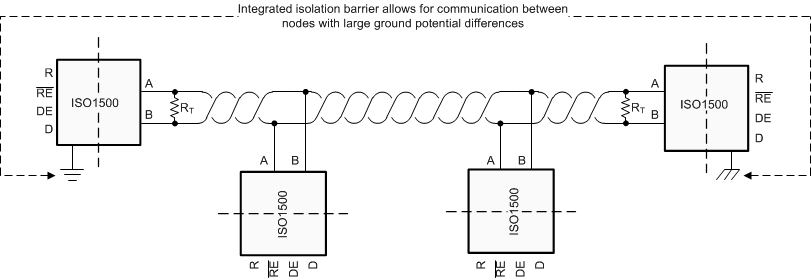ZHCSIV2C September 2018 – September 2019 ISO1500
PRODUCTION DATA.
- 1 特性
- 2 应用
- 3 说明
- 4 修订历史记录
- 5 Pin Configuration and Functions
-
6 Specifications
- 6.1 Absolute Maximum Ratings
- 6.2 ESD Ratings
- 6.3 Recommended Operating Conditions
- 6.4 Thermal Information
- 6.5 Power Ratings
- 6.6 Insulation Specifications
- 6.7 Safety-Related Certifications
- 6.8 Safety Limiting Values
- 6.9 Electrical Characteristics: Driver
- 6.10 Electrical Characteristics: Receiver
- 6.11 Supply Current Characteristics: Side 1(ICC1)
- 6.12 Supply Current Characteristics: Side 2(ICC2)
- 6.13 Switching Characteristics: Driver
- 6.14 Switching Characteristics: Receiver
- 6.15 Insulation Characteristics Curves
- 6.16 Typical Characteristics
- 7 Parameter Measurement Information
- 8 Detailed Description
- 9 Application and Implementation
- 10Power Supply Recommendations
- 11Layout
- 12器件和文档支持
- 13机械、封装和可订购信息
9.1 Application Information
The ISO1500 device is designed for bidirectional data transfer on multipoint RS-485 networks. The design of each RS-485 node in the network requires an ISO1500 device and an isolated power supply as shown in Figure 32.
An RS-485 bus has multiple transceivers that connect in parallel to a bus cable. Both cable ends are terminated with a termination resistor, RT, to remove line reflections. The value of RT matches the characteristic impedance, Z0, of the cable. This method, known as parallel termination, lets higher data rates be used over a longer cable length.
In half-duplex implementation, as shown in Figure 31, the driver and receiver enable pins let any node at any given moment be configured in either transmit or receive mode which decreases cable requirements.
 Figure 31. Half-Duplex Network Circuit
Figure 31. Half-Duplex Network Circuit